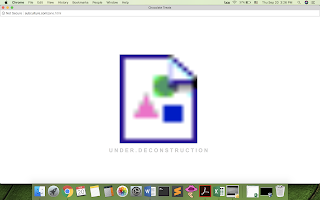Materiality of glitch poetry links different layers of electronic literature
In her paper Code.surface || Code.depth, Rita Raley uses the
example of the opening scene in Le
Mépris/Contempt (1963) by Jean-Luc Godard, where a woman seems to be
reading a script while other items and equipment of filming production can be seen
in the background. This scene appears to represent what the filming production
is like for a movie. However, the scene does not show the actual process, “Rather,
the opening of the film lays bare the symbolic conditions of production” (pg. 2).
And as Raley indicates, this is precisely what contemporary code art attempts
to do: give a symbolic representation of what is under the hood of electronic
literature.
Unlike the traditional literature that may be found printed
on a page, electronic literature is the product of a multi-layered structure,
where the code underneath instructs the technological devices used how to display or perform the art. This layered-structure as a concept has become an
important part of contemporary code art. Raley cites Edsger W. Dijkstra’s paper
“Complexity Controlled by Hierarchical Ordering of Function and Variability” to
describe how the code artist plays with this concept in the work he/she
produces. As she Raley states, “[w]ith the notion of multiple layers of
software comes the notion that layers leak into each other: ‘what is put in
layer 0 penetrates the whole of the design on top of it and the decision what
to put there has far reaching
Consequences’” (pg. 5)
This can be seen in Antonio Mendoza’s subculture.com page.
Here, Mendoza provides a series of images that can be changed simply by the
click of the mouse. However, in each page/image, there seems to be some sort of
glitch that makes the image shake uncontrollably or that shows images similar
to “error” messages indicating that a file (or more) did not load properly.
Below you will find an example of the latter, where a could-not-open-file icon
is seen with the phrase “Under.deconstruction” just below.
Mendoza’s work presented above provides a clear example of
the how code artists are playing with the concept of a multi-layered structure
in electronical literature. The artist, here, does not only show his own work,
but he also sends a message that the work displayed or performed is attached to
(or rather, is the product of) the code that is hidden underneath. This message
can be sent only by creating an illusion that the code is somehow broken. And
it is only until the reader/viewer has this idea of a broken code that she/he begins
to think about the source of the work—oh yeah, code was used to make this! This
realization connects two different layers of the structure: the deep structure
(the code) and the surface structure (the display/performance).
Questions for further discussion:
Following up on Luis's question regarding the use of the word "performance," I have used the term, specifically in this piece, to mean the display of the work in question. However, I also have been wondering what exactly "performance" or even "display" mean. Could these terms only be used on the description of code art? Can it be expanded to other electronic literature?
Another question I have is regarding code art as an object of admiration (not so much an object of study). It is clear that code artists try to connect the visual with what's underneath--the code. But I wonder what effect this can have for the viewer. Is there a specific target audience? Will this function have different results on different observers depending their familiarity with the concept of code art or electronic literature, in general?


Comments
Post a Comment